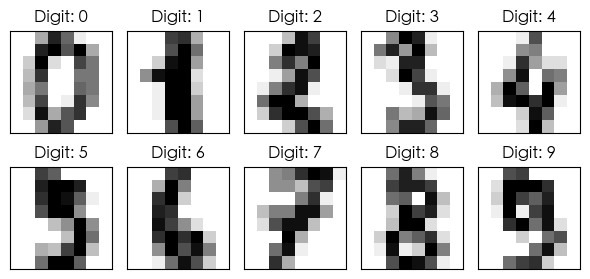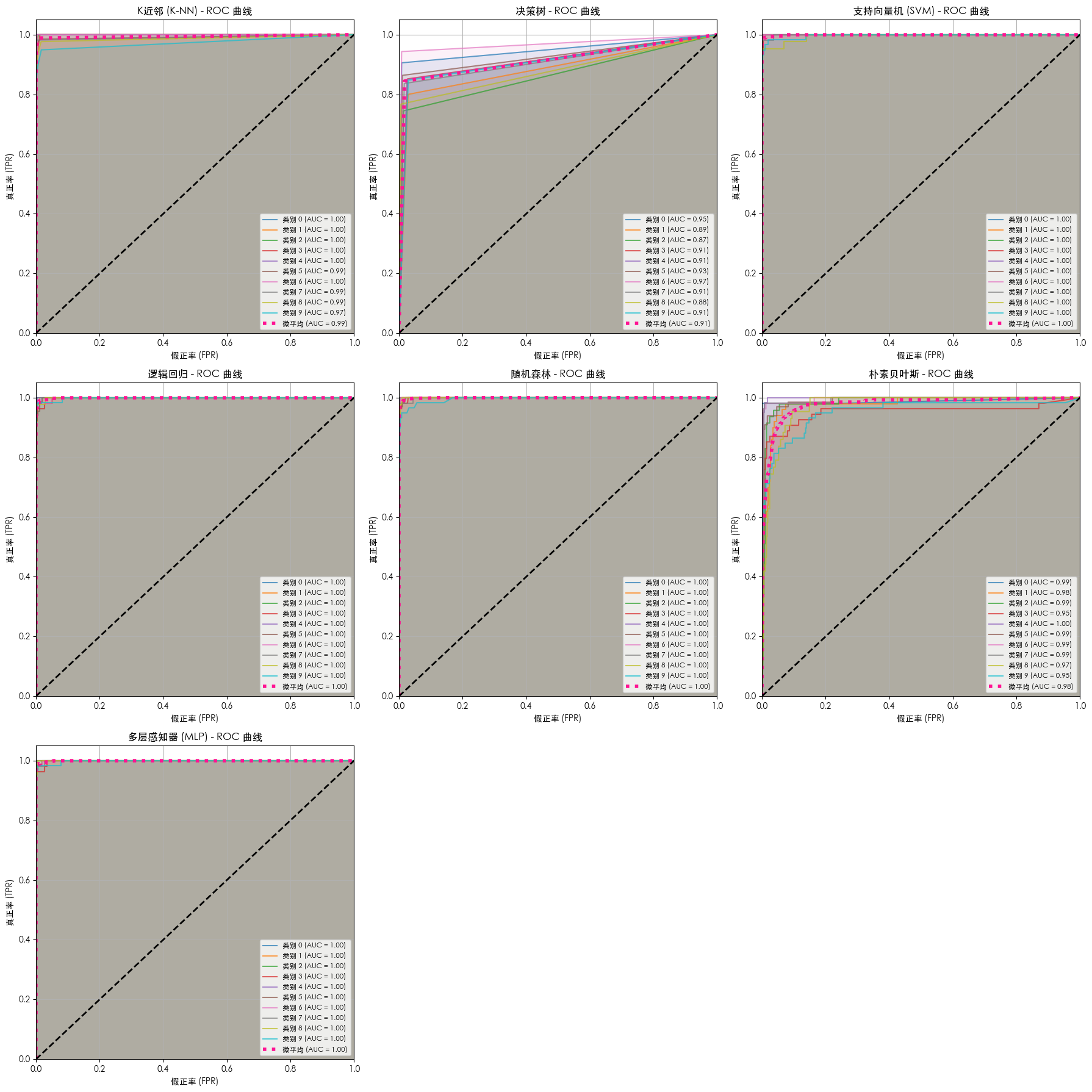SciKit-Learn 全面分析 digits 手写数据集
背景
digits 手写数字数据集,1797个样本,8x8像素灰度图像(64个特征),10个类别(0-9)
作为多分类任务的玩具数据,需要使用分类方法进行分析

步骤
- 加载数据集
- 拆分训练集、测试集
- 数据预处理(标准化)
- 选择模型
- 模型训练(拟合)
- 测试模型效果
- 评估模型
分析方法
对数据集使用 7 种分类方法进行分析
- K 近邻(K-NN)
- 决策树
- 支持向量机(SVM)
- 逻辑回归
- 随机森林
- 朴素贝叶斯
- 多层感知机(MLP)
代码
from sklearn.datasets import load_digitsfrom sklearn.model_selection import train_test_split
from sklearn.preprocessing import StandardScaler
from sklearn.decomposition import PCAfrom sklearn.neighbors import KNeighborsClassifier
from sklearn.tree import DecisionTreeClassifier
from sklearn.svm import SVC
from sklearn.linear_model import LogisticRegression
from sklearn.ensemble import RandomForestClassifier
from sklearn.naive_bayes import GaussianNB
from sklearn.neural_network import MLPClassifierfrom sklearn.metrics import accuracy_score, classification_report, roc_curve, auc
from sklearn.preprocessing import label_binarizeimport matplotlib.pyplot as plt
import numpy as np# 设置 Matplotlib 字体以正确显示中文
# 尝试使用多种常见中文字体,提高跨平台兼容性
plt.rcParams['font.sans-serif'] = ['SimHei', 'WenQuanYi Zen Hei', 'STHeiti', 'Arial Unicode MS']
# 解决保存图像时负号'-'显示为方块的问题
plt.rcParams['axes.unicode_minus'] = False def perform_digits_analysis():"""使用 scikit-learn 对手写数字数据集进行全面的分析。该函数包含数据加载、预处理、模型训练、评估和 ROC/AUC 可视化。"""print("--- 正在加载手写数字数据集 ---")# 加载手写数字数据集digits = load_digits()# 获取数据特征和目标标签X = digits.datay = digits.targettarget_names = [str(i) for i in digits.target_names]print("\n--- 数据集概览 ---")print(f"数据形状: {X.shape}")print(f"目标名称: {target_names}")# 将数据集划分为训练集和测试集X_train, X_test, y_train, y_test = train_test_split(X, y, test_size=0.3, random_state=42)print("\n--- 数据划分结果 ---")print(f"训练集形状: {X_train.shape}")print(f"测试集形状: {X_test.shape}")# 数据标准化print("\n--- 正在对数据进行标准化处理 ---")scaler = StandardScaler()X_train_scaled = scaler.fit_transform(X_train)X_test_scaled = scaler.transform(X_test)# 定义并训练多个分类器模型models = {"K近邻 (K-NN)": KNeighborsClassifier(n_neighbors=3),"决策树": DecisionTreeClassifier(random_state=42),"支持向量机 (SVM)": SVC(kernel='rbf', C=1.0, random_state=42, probability=True), # 必须设置 probability=True 来获取概率"逻辑回归": LogisticRegression(random_state=42, max_iter=1000),"随机森林": RandomForestClassifier(random_state=42),"朴素贝叶斯": GaussianNB(),"多层感知器 (MLP)": MLPClassifier(random_state=42, max_iter=300)}print("\n--- 模型训练与评估 ---")for name, model in models.items():print(f"\n--- 正在训练 {name} 模型 ---")# 使用标准化后的训练数据对模型进行拟合 (训练)model.fit(X_train_scaled, y_train)# 在标准化后的测试集上进行预测y_pred = model.predict(X_test_scaled)# 评估模型性能accuracy = accuracy_score(y_test, y_pred)report = classification_report(y_test, y_pred, target_names=target_names)print(f"{name} 模型的准确率: {accuracy:.4f}")print(f"{name} 模型的分类报告:\n{report}")print("\n--- ROC 曲线和 AUC 对比 ---")# 创建一个包含多个子图的图表num_models = len(models)cols = 3rows = (num_models + cols - 1) // colsfig, axes = plt.subplots(rows, cols, figsize=(18, 6 * rows))axes = axes.flatten()# 将多分类标签二值化,用于 ROC 曲线计算y_test_bin = label_binarize(y_test, classes=np.arange(10))# 循环遍历每个模型并绘制 ROC 曲线for i, (name, model) in enumerate(models.items()):ax = axes[i]# 获取每个类别的预测概率if hasattr(model, "predict_proba"):y_score = model.predict_proba(X_test_scaled)else: # 对于 SVC 这种没有 predict_proba 的模型,使用 decision_functiony_score = model.decision_function(X_test_scaled)# 计算每个类别的 ROC 曲线和 AUCfpr = dict()tpr = dict()roc_auc = dict()for j in range(len(target_names)):fpr[j], tpr[j], _ = roc_curve(y_test_bin[:, j], y_score[:, j])roc_auc[j] = auc(fpr[j], tpr[j])# 计算微平均 ROC 曲线和 AUCfpr["micro"], tpr["micro"], _ = roc_curve(y_test_bin.ravel(), y_score.ravel())roc_auc["micro"] = auc(fpr["micro"], tpr["micro"])# 绘制所有类别的 ROC 曲线并填充for j in range(len(target_names)):ax.plot(fpr[j], tpr[j], label=f'类别 {j} (AUC = {roc_auc[j]:.2f})', alpha=0.7)ax.fill_between(fpr[j], tpr[j], alpha=0.1)# 绘制微平均 ROC 曲线ax.plot(fpr["micro"], tpr["micro"], label=f'微平均 (AUC = {roc_auc["micro"]:.2f})',color='deeppink', linestyle=':', linewidth=4)# 绘制对角线 (随机猜测)ax.plot([0, 1], [0, 1], 'k--', lw=2)# 设置图表属性ax.set_xlim([0.0, 1.0])ax.set_ylim([0.0, 1.05])ax.set_xlabel('假正率 (FPR)')ax.set_ylabel('真正率 (TPR)')ax.set_title(f'{name} - ROC 曲线')ax.legend(loc="lower right", fontsize='small')ax.grid(True)# 隐藏未使用的子图边框for j in range(num_models, len(axes)):axes[j].axis('off')plt.tight_layout()plt.show()# 确保代码在作为主程序运行时才执行
if __name__ == "__main__":perform_digits_analysis()
结果
不同模型的 ROC 及 AUC 的对比

详情
--- 正在训练 K近邻 (K-NN) 模型 ---
K近邻 (K-NN) 模型的准确率: 0.9685
K近邻 (K-NN) 模型的分类报告:precision recall f1-score support0 1.00 1.00 1.00 531 0.94 1.00 0.97 502 0.96 0.98 0.97 473 0.94 0.94 0.94 544 0.98 0.98 0.98 605 0.98 0.97 0.98 666 0.96 1.00 0.98 537 1.00 0.98 0.99 558 0.95 0.93 0.94 439 0.95 0.90 0.92 59accuracy 0.97 540macro avg 0.97 0.97 0.97 540
weighted avg 0.97 0.97 0.97 540--- 正在训练 决策树 模型 ---
决策树 模型的准确率: 0.8444
决策树 模型的分类报告:precision recall f1-score support0 0.92 0.91 0.91 531 0.74 0.80 0.77 502 0.83 0.74 0.79 473 0.78 0.85 0.81 544 0.81 0.85 0.83 605 0.92 0.86 0.89 666 0.93 0.94 0.93 537 0.85 0.84 0.84 558 0.92 0.77 0.84 439 0.78 0.85 0.81 59accuracy 0.84 540macro avg 0.85 0.84 0.84 540
weighted avg 0.85 0.84 0.84 540--- 正在训练 支持向量机 (SVM) 模型 ---
支持向量机 (SVM) 模型的准确率: 0.9796
支持向量机 (SVM) 模型的分类报告:precision recall f1-score support0 1.00 1.00 1.00 531 1.00 1.00 1.00 502 0.94 1.00 0.97 473 0.98 0.94 0.96 544 0.98 1.00 0.99 605 0.97 1.00 0.99 666 0.98 1.00 0.99 537 1.00 0.96 0.98 558 0.95 0.95 0.95 439 0.98 0.93 0.96 59accuracy 0.98 540macro avg 0.98 0.98 0.98 540
weighted avg 0.98 0.98 0.98 540--- 正在训练 逻辑回归 模型 ---
逻辑回归 模型的准确率: 0.9704
逻辑回归 模型的分类报告:precision recall f1-score support0 1.00 1.00 1.00 531 0.98 0.94 0.96 502 0.94 1.00 0.97 473 1.00 0.93 0.96 544 1.00 0.98 0.99 605 0.95 0.95 0.95 666 0.98 0.98 0.98 537 1.00 0.98 0.99 558 0.89 0.98 0.93 439 0.95 0.97 0.96 59accuracy 0.97 540macro avg 0.97 0.97 0.97 540
weighted avg 0.97 0.97 0.97 540--- 正在训练 随机森林 模型 ---
随机森林 模型的准确率: 0.9741
随机森林 模型的分类报告:precision recall f1-score support0 1.00 0.98 0.99 531 0.96 0.98 0.97 502 0.98 1.00 0.99 473 0.98 0.96 0.97 544 0.97 1.00 0.98 605 0.97 0.95 0.96 666 0.98 0.98 0.98 537 0.98 0.98 0.98 558 0.95 0.95 0.95 439 0.97 0.95 0.96 59accuracy 0.97 540macro avg 0.97 0.97 0.97 540
weighted avg 0.97 0.97 0.97 540--- 正在训练 朴素贝叶斯 模型 ---
朴素贝叶斯 模型的准确率: 0.7833
朴素贝叶斯 模型的分类报告:precision recall f1-score support0 0.96 0.98 0.97 531 0.79 0.66 0.72 502 0.86 0.40 0.55 473 0.97 0.67 0.79 544 1.00 0.58 0.74 605 0.87 0.94 0.91 666 0.83 0.98 0.90 537 0.59 0.98 0.73 558 0.51 0.88 0.65 439 0.84 0.71 0.77 59accuracy 0.78 540macro avg 0.82 0.78 0.77 540
weighted avg 0.83 0.78 0.78 540--- 正在训练 多层感知器 (MLP) 模型 ---
多层感知器 (MLP) 模型的准确率: 0.9833
多层感知器 (MLP) 模型的分类报告:precision recall f1-score support0 1.00 1.00 1.00 531 1.00 1.00 1.00 502 0.98 1.00 0.99 473 1.00 0.94 0.97 544 0.98 1.00 0.99 605 0.97 0.98 0.98 666 0.98 0.98 0.98 537 1.00 0.98 0.99 558 0.93 0.98 0.95 439 0.98 0.97 0.97 59accuracy 0.98 540macro avg 0.98 0.98 0.98 540
weighted avg 0.98 0.98 0.98 540
